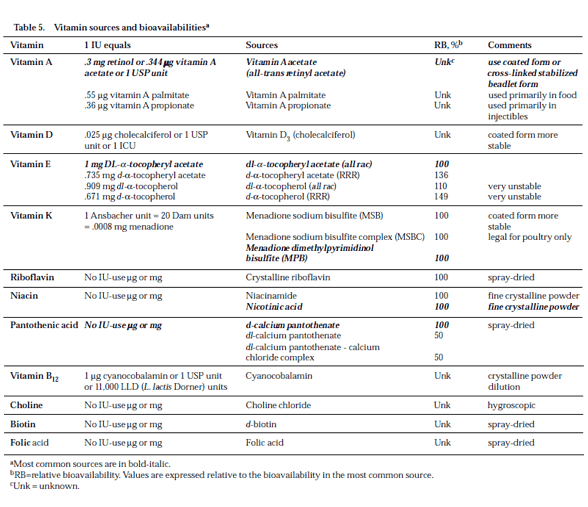Swine Nutrition Guide: Nutrient Sources - Vitamins
Vitamins -- Vitamins are organic compounds that are required in very small amounts for maintenance, growth, reproduction and lactation.
Some vitamins (thiamin, vitamin B6, and vitamin C) probably do not need to be included in the diet because they are synthesized from other compounds in the body or by microorganisms in the digestive tract, or grain-soybean meal diets contain sufficient amounts to meet the pig’s requirement.
Vitamins are classified as either fat soluble (vitamins A, D, E and K) or water soluble. The water soluble vitamins routinely added to all swine diets include niacin, pantothenic acid, riboflavin and vitamin B12. In addition, biotin, choline and folic acid routinely are added to diets for breeding swine.
Vitamin potency in feed and manufactured products will decrease with exposure to light, high humidity, heat, rancid fat and oxygen.
Vitamins can be destroyed when in contact with minerals over a prolonged period of time. For best results, store basemixes and trace mineral-vitamin premixes in a cool, dry, dark place and use them within 30 days of purchase. Premixes containing only vitamins can be stored longer.
What are the major sources of vitamins for pigs?
Major sources of supplemental vitamins for pigs are listed in Table 5. Although vitamins are present in grains and protein supplements, it is usually better to rely on vitamins supplied by sources in Table 5. The reason is that vitamins in grains and protein sources may be lost during storage, drying and processing or may be unavailable to the pig.
An exception is made for choline, folic acid and biotin. We believe that the amounts of these vitamins that are present in grains and protein sources are sufficient for normal growth, but they should be supplemented in diets for breeding swine. All the vitamin recommendations in this publication are added levels.
Is there a difference between synthetic and natural forms of vitamin E?
Yes. The most common form of synthetic vitamin E used is dl-a- tocopheryl acetate. It is very stable during storage and/or in mixed feed. The natural form of vitamin E (d-a-tocopherol) sometimes is used.
It is less stable and exhibits a decline in activity over time. However, it has a higher relative biological activity than dl-a-tocopheryl acetate (Table 5). In one study, starting pigs performed the same whether dl-a-tocopheryl acetate or d-a-tocopherol in an encapsulated matrix was included in the feed.
However, d-a-tocopherol was more effectively absorbed than dl-a- tocopheryl acetate. Make decisions on which source of vitamin E to use primarily on price per unit of available vitamin and on how long the vitamin supplement or feed will be stored.

This article hasn't been commented yet.


Write a comment
* = required field